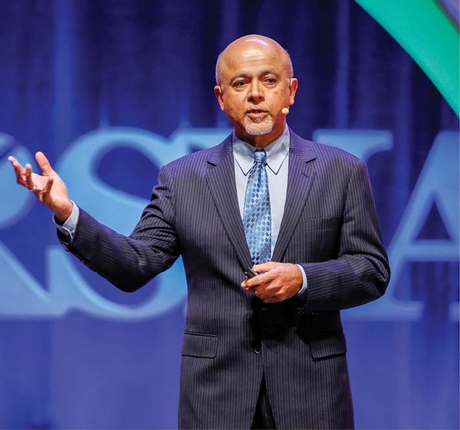Finding the care in caring for patients is one way that physicians can find meaning in their roles in a professional environment that is rapidly becoming inundated with technology.

Verghese
That was the message in the Sunday Opening Plenary lecture delivered by Abraham Verghese, MD, a New York Times bestselling author and the Linda R. Meier and Joan F. Lane Provostial Professor and vice chair for the Theory and Practice of Medicine at the Stanford University School of Medicine in California.
Referencing his own experience with patients, Dr. Verghese reminded attendees that when physicians shortcut the physical exam or order tests too quickly and too often, instead of spending time talking to and examining the patient, simple diagnoses can be missed.
"By not performing a physical examination of the patient, physicians are losing a ritual, one that is transformative, transcendent and is at the heart of the patient-physician relationship," Dr. Verghese said.
Historically, physical examination and touch was the physician's only tool. In the modern era, Dr. Verghese believes that the patient in the bed has almost become an icon, often replaced by, what he calls, the "iPatient," or the patient records that reside in the physician's computer.
"The iPatient is getting wonderful care all across America. The real patient often wonders 'Where is everyone?' and 'When are they going to come by and explain things to me?'," Dr. Verghese said. "There is a real disjunction between the patient's perception, and our own perceptions as physicians, of the best medical care."
Using the example of how rounds have changed in the hospital, he said physicians used to gather around the patient to discuss their diagnosis and treatment. Now, rounds often take place in a conference room, where physicians are gathered around a table, reviewing images and data. The most critical piece missing is the patient.
Four Consequences of Remote Model of Care
The consequences of this remote model of medicine are four-fold, Dr. Verghese said.
First, patients are dissatisfied when physicians spend more time inputting information on their computer than paying attention to them personally. Referencing several patient memoirs about illness, he noted that we all want to be recognized and have our illnesses witnessed.
"Each man or woman is ill in his or her own way and wants to be recognized as special," Dr. Verghese said. "We all have this need."
Secondly, studies have shown that physician wellness can be greatly improved when they step away from technology. Particularly for radiologists, Dr. Verghese noted that they struggle with burnout because of, "productivity demands, a sense of isolation in the reading room and a misunderstood role in health care."
The third consequence of this remote model, he said, is medical error. He reminded the audience that, "patients have a front side and a backside," and that putting eyes on a patient, not relying primarily on the data, can help prevent medical errors and misdiagnoses.
Finally, he noted a loss of ritual as the fourth consequence. We engage in rituals to signify crossing a threshold, he said. Dr. Verghese spoke about the privilege afforded physicians to touch and examine patients, and that there is a ritual to the process when it is done thoughtfully. He emphasized the importance of working with medical trainees to ensure that the skill of performing a physical exam is passed down and that trainees are shown by example the significance of this ritual of touch to patient care.
This transformation of moving toward more contemplative and attentive health care offers myriad benefits for the patient, and ultimately for the physician.
"Preserving the 'person'-ality of the patient helps patients maintain their identity during a time of stress and fear when awaiting a diagnosis, and the physical examination by the physician validates the patient's complaint by focusing on their body providing a symbolic centering," Dr. Verghese said. "Ultimately, this work of bringing everything back to the patient and the patient's body, helps the patient connect an image, biopsy report or lab test to their personhood."
Related links:

